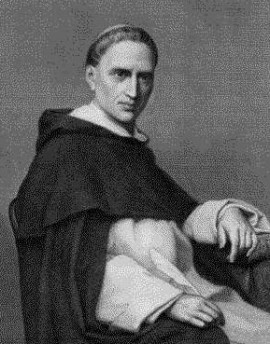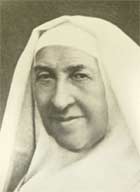Biographies of Catholic Saints
Saints are men and women who live their life as followers of Christ in their ordinary life and a source of wisdom for those who would like to be faithful to the Gospel of our Lord Jesus Christ. May their examples inspired us to live the way of life Jesus has taught usArchive for Jesus
Blessed Marie-Eugénie of Jesus
(1817-1898)
Anne-Eugénie Milleret was born in 1817 in Metz after Napoleon’s complete defeat and the restoration of the monarchy. She belonged to a nonbelieving and financially comfortable family and it seemed unlikely that she would trace a new spiritual path across the Church of France.
Her father, a follower of Voltaire and a liberal, was making his fortune in the banking world and in politics. Anne-Eugénie’s mother provided the sensitive daughter with an education, which strengthened her character and gave her a strong sense of duty. Family life developed her intellectual curiosity and a romantic spirit, an interest in social questions and a broad worldview.
Like her contemporary, George Sand, Anne-Eugénie went to Mass on feast days and received the sacraments of initiation, as was the custom, but without any real commitment. However, her first Communion was a great mystical experience that foretold the secret of her future. She did not grasp its prophetic meaning until much later, when she recognized it as her path toward total belonging to Jesus Christ and the Church.
Her youth was happy but not without suffering. She was affected when still a child by the death of an elder brother and a baby sister. Her health was delicate and a fall from a horse left serious consequences. Anne-Eugénie was mature for her age and learned how to hide her feelings and to face up to events.
Later, after a prosperous period for her father, she experienced the failure of his banks, the misunderstanding and eventual separation of her parents and the loss of all security. She had to leave her family home and go to Paris while Louis, closest to her in age and faithful companion, went to live with their father. Anne-Eugénie went to Paris with the mother she adored, only to see her die from cholera after a few hours of illness, leaving her alone at the age of 15 in a society that was worldly and superficial. Searching in anguish and almost desperate for the truth, she arrived at her conversion thirsty for the Absolute and open to the Transcendent.
When she was 19, Anne-Eugénie attended the Lenten Conferences at Notre Dame in Paris, preached by the young  , already well-known for his talent as orator.
, already well-known for his talent as orator.
Lacordaire was a former disciple of Lamennais — haunted by the vision of a renewed Church with a special place in the world. He understood his time and wanted to change it. He understood young people, their questions and their desires, their idealism and their ignorance of both Christ and the Church.
His words touched Anne-Eugénie’s heart, answered her many questions, and aroused her generosity. Anne-Eugénie envisaged Christ as the universal liberator and his kingdom on earth established as a peaceful and just society.
“I was truly converted,” she wrote, “and I was seized by a longing to devote all my strength or rather all my weakness to the Church which, from that moment, I saw as alone holding the key to the knowledge and achievement of all that is good.”
Just at this time, another preacher, also a former disciple of Lamennais, appeared on the scene. In the confessional, Father Combalot recognized that he had encountered a chosen soul who was designated to be the foundress of the congregation he had dreamed of for a long time. He persuaded Anne-Eugénie to undertake his work by insisting that this congregation was willed by God who had chosen her to establish it. He convinced her that only by education could she evangelize minds, make families truly Christian, and thus transform the society of her time. Anne-Eugénie accepted the project as God’s will for her and allowed herself to be guided by the Abbé Combalot.
At 22, Marie Anne-Eugénie became foundress of the Religious of the Assumption, dedicated to consecrate their whole life and strength to extending the Kingdom of Christ in themselves and in the world. In 1839, Anne-Eugénie, with two other young women, began a life of prayer and study in a flat at rue Ferou near the church of St. Sulpice in Paris. In 1841, under the patronage of Madame de Chateaubriand, Lacordaire, Montalembert and their friends, the sisters opened their first school. In a relatively short time there were 16 sisters of four nationalities in the community.
Marie Anne-Eugénie and the first sisters wanted to link the ancient and the new — to unite the past treasures of the Church’s spirituality and wisdom with a type of religious life and education able to satisfy the demands of modern minds. It was a matter of respecting the values of the period and at the same time, making the Gospel values penetrate the rising culture of a new industrial and scientific era. The spirituality of the congregation, centered on Christ and the incarnation, was both deeply contemplative and dedicated to apostolic action. It was a life given to the search for God and the love and service of others.
Marie Anne-Eugénie’s long life covered almost the whole of the 19th century. She loved her times passionately and took an active part in their history. Progressively, she channeled all her energy and gifts in tending and extending the congregation, which became her life work.
God gave her sisters and many friends. One of the first sisters was Irish, a mystic and her intimate friend whom she called at the end of her life, “half of myself.” Kate O’Neill, called Mother Thérèse Emmanuel in religion, is considered as a co-foundress.
Father Emmanuel d’Alzon, who became Marie Anne-Eugénie’s spiritual director soon after the foundation, was a father, brother or friend according to the seasons. In 1845, he founded the Augustinians of the Assumption and the two founders helped each other in a multitude of ways over a period of 40 years. Both had a gift for friendship and they inspired many lay people to work with them and the Church. Together, as they followed Christ and labored with him, the religious and laity traced the path of the Assumption and took their place in the great cloud of witnesses.
In the last years of her life, Mother Marie Anne-Eugénie experienced a progressive physical weakening, which she lived in silence and humility — a life totally centered on Christ. She received the Eucharist for the last time on March 9, 1898, and on March 10, she passed over to the Lord. She was beatified by Pope Paul VI on Feb. 9, 1975, in Rome.
Today, the Religious of the Assumption are present in 34 countries — eight in Europe, five in Asia, 10 in America and 11 in Africa. Almost 1,200 sisters form 170 communities throughout the world.
The Lay Assumption — Assumption Together — made up of Friends of the Assumption and Communities or Fraternities of the Assumption, are numerous: Thousands of Friends and hundreds of Lay Assumption are committed to live according to the Way of Life.













